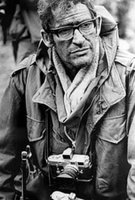 War Remnants Museum
War Remnants MuseumThe War Remnants Museum was opened in September 1975, four months after tank number 842 crashed through the gates of the Presidential Palace in Saigon, ending the war. When it was first opened, it was called the Museum of American War Crimes. It was later renamed to the War Crimes Museum and finally, with the focus on tourism, renamed again as the War Remnants Museum. The museum, not surprisingly, captures a view of the American War from a victor’s point of view. Despite the absence of any mention of the threatening factor that the spread of communism had on the West during the Cold War and the shared responsibility for senseless brutality executed by all that were under arms, the War Remnants Museum coverage was generally cognizant of the sensibilities to all that may visit.
The museum has eight themed areas. One starts with a section called Historic Truths with photos ranging from American tanks supplied to the French to American G.I. landing in Danang in March 1965. The final themed area, called War and Peace, is a collection of children’s paintings.
 Vestiges of War Crimes and Aftermaths was probably the most difficult display to view. A large color photograph of the Son My (My Lai) massacre held a prominent position on the wall. Also displayed were photos of the results on both the environment and people of the chemical defoliant called Agent Orange. One Agent Orange photo, indicating the extent of the defoliant’s reach, was one of an American mother whose soldier son was also a victim of exposure
Vestiges of War Crimes and Aftermaths was probably the most difficult display to view. A large color photograph of the Son My (My Lai) massacre held a prominent position on the wall. Also displayed were photos of the results on both the environment and people of the chemical defoliant called Agent Orange. One Agent Orange photo, indicating the extent of the defoliant’s reach, was one of an American mother whose soldier son was also a victim of exposure  to Agent Orange. More difficult for Jay was to see the grenade launcher weapon he carried 35 years ago as a young Marine displayed in this area.
to Agent Orange. More difficult for Jay was to see the grenade launcher weapon he carried 35 years ago as a young Marine displayed in this area. The Requiem section dedicated to the 134 journalists from 11 nations who died in the war provided a more universal
The Requiem section dedicated to the 134 journalists from 11 nations who died in the war provided a more universal view of the war. The gallantry of war is far less evident when looking into the faces of men bedraggled in combat uniforms with no country affiliation, with only cameras hung from their necks. It was a unique collection of photos of American G.I.’s we had seen in Time magazine, hung along side photos of North Vietnamese soldiers never seen in our western press.
view of the war. The gallantry of war is far less evident when looking into the faces of men bedraggled in combat uniforms with no country affiliation, with only cameras hung from their necks. It was a unique collection of photos of American G.I.’s we had seen in Time magazine, hung along side photos of North Vietnamese soldiers never seen in our western press. Another section of the museum that touched on the “international support for the Vietnamese people in their Resistance War” was not very candid, revealing that the “support” was mainly opposition to the war. The famous photo of a student kneeling over the body of another student killed at Kent State was displayed. It was a difficult time for everyone.
Another section of the museum that touched on the “international support for the Vietnamese people in their Resistance War” was not very candid, revealing that the “support” was mainly opposition to the war. The famous photo of a student kneeling over the body of another student killed at Kent State was displayed. It was a difficult time for everyone. Outside, there were displays of American military artillery, tanks and Huey helicopters. All this equipment seemed so modern during the war, but now the tools of that war are literally museum pieces.
Outside, there were displays of American military artillery, tanks and Huey helicopters. All this equipment seemed so modern during the war, but now the tools of that war are literally museum pieces.Our unguided tour lasted one hour. We were pleased to move on with our visit and lives, as we think most people are who are touched by this museum.

0 Comments:
Post a Comment
<< Home